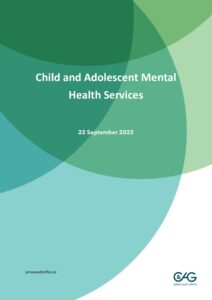
Thursday 22 September 2022 - Report
Thursday 22 September 2022 - Report
Topics: Value for Money
Departments: All
Sector: Health & Social Care

Report: pdf (727.02 KB)
Download in full ↓Improving mental health and wellbeing is a major public health challenge. In part, this is because the underlying issues tend to be complex, and people’s needs can be different. Evidence suggests that mental health problems in childhood and adolescence have a significant impact on physical health, education and on the ability to find and sustain employment.
The Government of Jersey has stated in the Government Plan 2022-2025 that ‘the physical, emotional, and mental health of the Island’s children and young people remain of the highest priority.’
Child and Adolescent Mental Health Services (CAMHS) comprises specialist mental health services for children and young people (up to the age of 18) and their families. CAMHS provides a range of services including assessment, diagnosis and treatment for children and young people experiencing:
CAMHS also provides specialist community-based services for those experiencing specific mental health issues such as psychosis and eating disorders. Services include individual therapy, family therapy, parent counselling and group therapy (where children, young people or carers with similar difficulties are seen together in groups).
The number of referrals to CAMHS has risen over recent years and there continues to be a high level of demand for CAMHS.
The Government Plan 2022-2025 includes planned investment of over £8 million for the implementation of a new model of care for children and young people’s emotional wellbeing and mental health. As part of this new model of care, CAMHS is being redesigned.
The review has evaluated:
The review has considered all aspects of CAMHS provision including services delivered by partners both on and off-Island. It has focussed on the responsibilities of the Children’s Health and Wellbeing Service within the Integrated Services and Commissioning function of CYPES. It has not considered the work of other CYPES functional areas such as children’s social work or child and family support.
The Government has committed to investment in the Children’s Health and Wellbeing Transformation Programme, including CAMHS, through the Government Plan 2022-2025. This investment is supported by a robust Strategy launched in February 2022.
Governance, data collection, risk and performance management for CAMHS have been weak. For the Strategy to lead to a step change in service quality and range of provision it will need to be supported by stronger and more effective governance and other arrangements and more specific and detailed implementation plans.

Associate Member of EURORAI - a cooperation project between public sector supervisory bodies in Europe